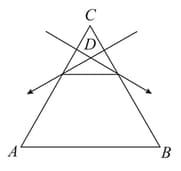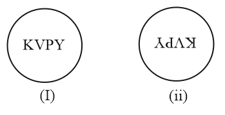What is thick lens? How it is different from the thin lens?
Important Questions on Ray Optics and Optical Instruments
In the given figure, what is the angle of prism?

A thin prism of angle made up of glass of refractive index is combined with another prism made up of glass of refractive index to produce dispersion without deviation. Then find the angle of the second prism.
Two thin lenses are in contact with each other. One of these is a concave lens of focal length and the other is a convex lens of the same focal length. Determine the focal length of the combination and state how it behaves.
The word is written on board and viewed through different lenses such that board is at a distance beyond the focal length of the lens.

Ignoring magnification effects, consider the following statements.
Image has been viewed from the planar side of a plano-convex lens and image
from the convex side of a plano-convex lens.
Image has been viewed from the concave side of a plano-concave lens and image from the convex side of a plano-convex lens.
Image has been viewed from the concave side of a plano-concave lens and image from the planar side of a plano-convex lens. Image has been viewed from the planar side of a plano-concave lens and image from the convex side of a plano-convex lens.
Which of the above statements are correct?

